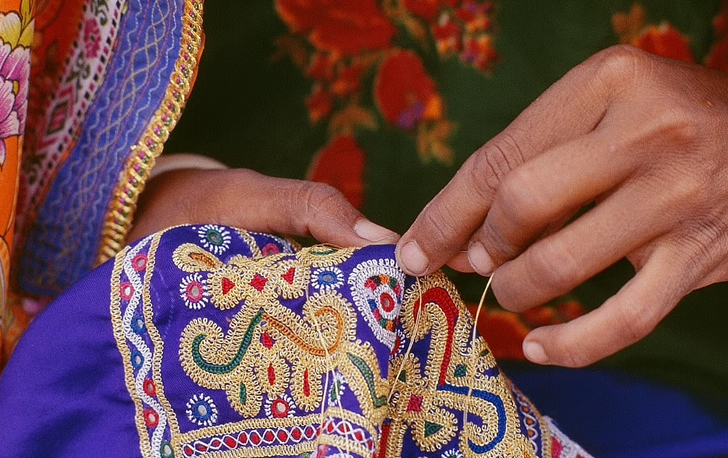Traditional Embroidery of India
Indian embroidery is as diverse as its land and culture and includes a panoramic array of artistic embroidery techniques . Every region boasts of a unique style which doesn’t just display an intricate art but goes beyond that to form a way of communication . Much of Indian embroidery reflects nature , folklore and culture of the region it hails from. Following are the most popular types of Indian embroidery.
Aari (Lucknow, Rajasthan)
This is a method of stitching that is done on tightly stretched fabric , making long stitches using an awl, a hooked needle similar to a crochet needle.
Chamba Rumal (Himachal Pradesh)
This technique is done on an unbleached muslin handkerchief and uses a double satin stitch to recreate miniature paintings with thread and needle.
Chikankari (Lucknow)
This highly renowned white floral embroidery is made by utilising about 35 different stitches to create a lace like effect. Traditional it was white-on-white (whitework) but these days chikan embroidery is done in different colours.
Gota Patti (Rajasthan)
Gota work or Gota Patti is a type of appliqué using gold or silver lace. Small bits of zari( metallic lace) is stitched onto the fabric with sewn-down edges to create patterns. This work is extensively used in bridal wear.
Kantha (West Bengal; Odisha)
This is a a trending technique because of its sustainable approach that quilts together layers of recycled/upcycled fabrics using a running stitch, over which colourful and vibrant embroidery patterns are added.
Kashida (Kashmir)
Inspired by the beautiful nature of Kashmir, this needlework technique, traditionally practised by the menfolk, creates motifs of birds, flowers and fruits using thick coloured threads and beads.
Kasuti (Karnataka)
This folk embroidery is traditionally made by counting the threads of the weft and warp, using small stitches, with the patterns often being reversible. Some motifs involve up to 5,000 hand stitches to create patterns like the chariots and palanquins.
Mukaish Uttar Pradesh)
Distinguished by a dotted silver or gold pattern as an adornment for Chikankari work. It involves twisting thin metallic threads to create patterns over the fabric and is locally referred to as ‘sachcha kaam’.
Zardosi (Uttar Pradesh)
This is an elaborate and intricate embroidery technique that is distinguished by the use of gold or silver wrapped-threads and embellishments.
Phulkari (Punjab)
A colourful form embroidery , Phulkari is characterised by darning stitches on the reverse side of a vibrantly dyed hand-spun cotton to create beautiful patterns.
Sujini (Bihar)
This style of embroidery is made using outlines in chain stitch and filled with a running stitch. The designs depict social and domestic issues.
Tilla (Kashmir)
Tilla is done by delicately sewing gold or silver imitation threads over fabric to create a range of designs. This arduous art is largely done on exquisite fabrics like pashmina and cashmere.
Toda (Tamil Nadu)
Also known as Pohor , Toda embroidery is done on thick white unbleached cotton cloth using thick red or black cotton or wool threads to create repetitive designs.

